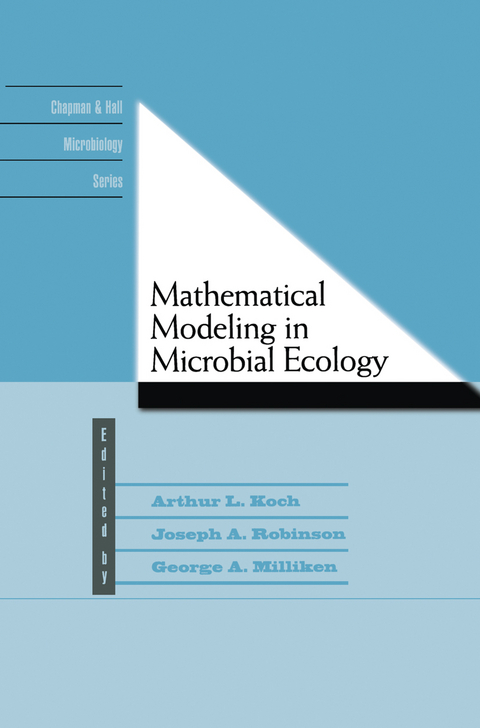
Mathematical Modeling in Microbial Ecology
Chapman and Hall (Verlag)
978-0-412-03511-1 (ISBN)
1. What is Happening to Microbial Ecology?.- 1. Introduction.- 2. Analytical Methods.- 3. Kinetic Aspects.- 4. Principles of Kinetic Modeling.- 5. Progress in Statistical Methods.- 6. Conclusions.- 2. Modeling Microbial Processes: An Overview of Statistical Considerations.- 1. Introduction.- 2. Model Identification versus Discrimination.- 3. The Least-Squares Criterion.- 4. Model Identification.- 5. Model Discrimination.- 6. Optimal Experiments for Parameter Estimation.- 7. Concluding Remarks.- References.- 3. Analysis of Repeated Measures Data Using Nonlinear Models.- 1. Introduction.- 2. The Model.- 3. Parameter Estimation.- 4. Comparing the Treatments.- 5. Constructing Confidence Bands for the Models.- 6. Example 1: Growing Cookies.- 7. Example 2: Cumulative Radioactive CO2 Production.- 8. Summary.- References.- 4. The Monod Model and Its Alternatives.- 1. Jacques Monod: His Life and Work.- 2. The Monod Model and Its Derivations.- 3. Limitation of the Hyperbolic Model.- 4. The Blackman (1905) Model and the Best (1955) Model.- 5. Still More Complication: The Phosphotransferase System.- 6. Still More Complications: The Kinetic Contribution of Porins and Passage through the Outer Membrane.- 7. The Experimental Measurement of Glucose Consumption.- 8. Selection of a Mutant Growing More Avidly at Low Glucose Concentrations.- 9. The Data Fitting: The Role of Models.- 10. The Statistical Fitting.- 11. Diffusion Limitation and Effect of Multiple Layers.- 12. The Effect of the Variation of the Surface Area to Volume during the Cell Cycle.- 13. Grave Omissions.- 14. Conclusions.- References.- 5. Using Transport Model Interpretations of Tracer Tests to Study Microbial Processes in Groundwater.- 1. Introduction.- 2. The Groundwater Environment.- 3. Measuring Microbial Processes in an Aquifer.- 4. Tracer-Test Technology.- 5. Transport-Process Models.- 6. Assessing Methane Oxidation.- 7. Assessing Denitrification.- 8. Future Applications and Limitations.- References.- 6. Modeling of Pesticide Biodegradation in Soil Daniel R. Shelton, Michael A. Doherty, Timothy B. Parkin, and.- 1. Introduction.- 2. Modeling.- 3. More Elaborate Models.- 4. Effect of Microbial Numbers.- 5. Role of Sorption.- 6. Summary.- References.- 7. Modeling Nitrogen Transformation in Soil.- 1. Introduction.- 2. Using Models to Calculate Data.- 3. Using Models to Understand N Cycle Transformations and Their Regulation.- 4. Using Models to Make Predictions about N Cycling.- 5. Summary.- References.- 8. Construction and Analysis of Static, Structured Models of Nitrogen Cycling in Coastal Ecosystems.- 1. Introduction.- 2. Methods.- 3. Model Development.- 4. Analysis Results and Interpretation.- 5. Conclusions and Subsequent Directions.- References.- 9. A Modeling Approach to Elucidating the Distribution and Rates of Microbially Catalyzed Redox Reactions in Anoxic Groundwater.- 1. Introduction.- 2. Use of H2 Concentrations to Predict Terminal Electron-Accepting Processes in Anoxic Groundwater.- 3. Estimating Rates of Microbial Processes with Geochemical Modeling.- 4. Conclusions.- References.- 10. From the Ground Up: The Development and Demonstrated Utility of the Ruminai Ecosystem Model.- 1. Introduction.- 2. Balance Models of Rumen Digestion.- 3. Dynamic Models of Ruminant Digestion.- 4. Early Dynamic Models.- 5. Current Dynamic Models.- References.- 11. Mathematical Models of Bacterial Chemotaxis.- 1. Introduction.- 2. Population Balance Models.- 3. Cellular Dynamics Simulation.- 4. Comparison of Modeling Approaches.- 5. Application to Multiple Stimuli.- 6. Concluding Remarks.-References.
| Reihe/Serie | Chapman & Hall Microbiology Series |
|---|---|
| Zusatzinfo | XIII, 273 p. |
| Verlagsort | London |
| Sprache | englisch |
| Maße | 155 x 235 mm |
| Themenwelt | Informatik ► Weitere Themen ► Bioinformatik |
| Mathematik / Informatik ► Mathematik ► Angewandte Mathematik | |
| Naturwissenschaften ► Biologie ► Mikrobiologie / Immunologie | |
| ISBN-10 | 0-412-03511-1 / 0412035111 |
| ISBN-13 | 978-0-412-03511-1 / 9780412035111 |
| Zustand | Neuware |
| Haben Sie eine Frage zum Produkt? |
aus dem Bereich


